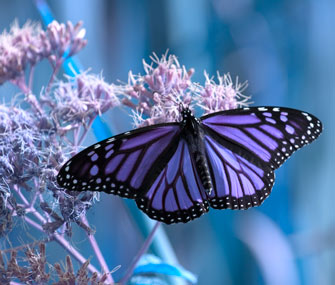A Beginner’s Guide to Butterfly Watching
Published on May 21, 2013

On June 1, lepidopterists everywhere will don their binoculars and celebrate Butterfly Awareness Day. But this annual holiday isn't just for experienced butterfly watchers; it's also a great opportunity for amateurs to start learning about butterflies.
Butterfly watching has grown more popular in recent years, and for good reason. There's little required to get started — just a pair of binoculars, a keen eye, and some field clothes — although a field guide is also helpful.
To learn more about butterfly watching and why it's gaining popularity, we chatted with Court Whelan, who has been involved in both the business and scientific arenas of ecotourism for the past nine years. Whelan holds a doctorate degree in Ecotourism Entomology (a program that he helped create at the University of Florida) and is an internationally recognized expert in ecotourism, entomology, and the role they play together in promoting conservation on a global scale.
Where to Go
"There are two main things people look for with butterfly watching," Whelan says. "The most important is diversity; they want a high count of different species. The second is assemblages of the same species."
Your ideal butterfly watching location will depend on which of these is your goal. If you're aiming to see diversity, you'll want to head to an area like Central and South America. "Near the equator is where you'll see the highest species count. It's somewhere in the 4000's in Ecuador and Peru," Whelan says.

The diversity you'll find in any given area is dictated by the variety of climate zones. Take Ecuador for example. "If you're low, at sea level or near it, it's hot, humid and rains a lot," Whelan explains. "As you go up in elevation in the Andean mountains, you find multiple climate and life zones, which means there are different plants for butterflies to feed on and lay eggs on. Although there will be some overlap in the transition zones, the butterflies you find at the Amazon basin will be totally different than what you'll find at 10,000 feet."
If a trip to the equator isn't in the cards for you, there are plenty of places to find wide butterfly diversity in the United States. Florida and Arizona are two of the most popular U.S. destinations.
If you're more interested in seeing enormous numbers of the same butterfly, there are several options. The most well known is the gathering of 2 billion Monarch butterflies that migrate from southern Canada and across the U.S. to either the California coast or central Mexico for the winter. There are several species with large populations in Florida, too, like the Viceroys you can find streaming down the Interstate in huge quantities.
What to Do
Whelan has a few tips for folks just getting started in butterfly watching. First and foremost, keep your expectations in check. "People often go to a tropical rainforest, or someplace that just exemplifies wildlife, like in the movies, and they expect to see butterflies everywhere. But remember, butterflies don't really want to be seen. Many have camouflage, and come out at different times of day," Whelan says. "Don't expect to be swarmed. Just be happy with seeing that one rare species you've never seen before, or witnessing a new behavior, or even just enjoying your surroundings."
Also, study up. "If you really want to get into butterfly watching, learn as much as you can. Not only will it help you identify species, but you'll have more fun," he says. The easier it is for you to identify a species on the spot, the more likely you are to realize you're seeing an unusual behavior.
Why It Matters
Butterfly watching isn't just fun; it's an important aspect of conservation through "citizen science." "The more you know from reading field guides, joining organizations, taking classes or even just Internet searches, the more appreciation and understanding you'll have for what you're seeing," Whelan says.

Say, for example, you recognize the first Monarch of the season. You can then report that to an organization like the North American Butterfly Association, which can include your findings in their research, all of which helps with conserving biodiversity. "We're finding that 'citizen science' is almost more important than anything else," Whelan explains.
In addition to assisting with Lepidoptera research, butterfly watching contributes to an overall conservation culture within the watcher's community. "We’re losing a lot of our species to extinction on a global scale," Whelan says. "Going out and looking at butterflies imparts a strong appreciation in the butterfly watcher and everyone in their life, because they’ll share stories and they’ll have an appreciation for the environment, which will be passed along to those close to them."
How to Get Involved
While you can gain a plethora of knowledge from a few basic Internet searches, Whelan suggests joining an organization like the North American Butterfly Association, the Association for Tropical Lepidoptera or the Lepidopterist Society. This will give you an automatic community that will not only share current findings and information with you, but might also be a great resource for planning a butterfly watching trip.
More and more ecotourism companies are offering these trips too, so it may be worth asking about the option when you're planning your next environmentally focused vacation.





